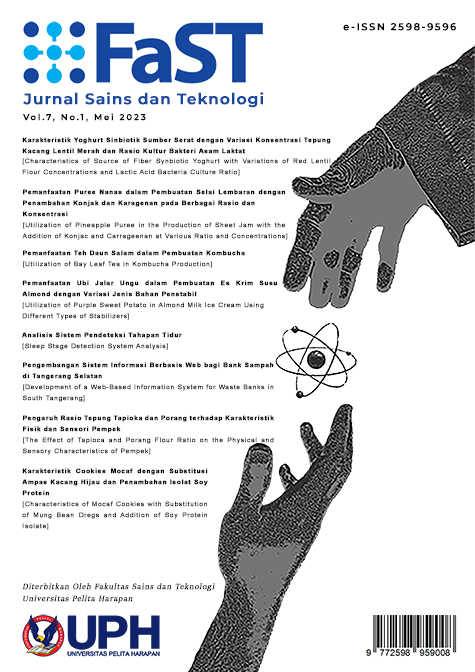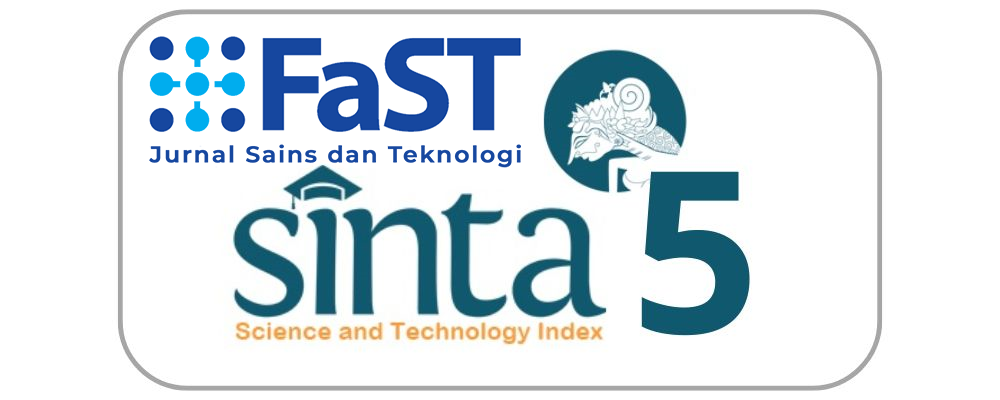KARAKTERISTIK YOGHURT SINBIOTIK SUMBER SERAT DENGAN VARIASI KONSENTRASI TEPUNG KACANG LENTIL MERAH DAN RASIO KULTUR BAKTERI ASAM LAKTAT [CHARACTERISTICS OF SOURCE OF FIBER SYNBIOTIC YOGHURT WITH VARIATIONS OF RED LENTIL FLOUR CONCENTRATIONS AND LACTIC ACID BACTERIA CULTURE RATIO]
DOI:
https://doi.org/10.19166/jstfast.v7i1.6541Kata Kunci:
red lentil, synbiotic, yogurtAbstrak
Yogurt is a product of fermentation by lactic acid bacteria which is mainly made from cow’s milk. The starter cultures used in this research were Streptococcus thermophilus, Lactobacillus plantarum, and Lactobacillus acidophilus. Lactobacillus plantarum and Lactobacillus acidophilus were used as probiotic cultures for red lentil symbiotic yogurt. Red lentils contain prebiotic that can be used as a nutrient for lactic acid bacteria. Red lentil flour contains moisture content 7,21%, dietary fibre 9,93%, inulin 3,03%. The main objective of this research was to determine the best concentration of red lentil flour and the ratio of culture. Synbiotic yoghurt was made with various concentrations of red lentil flour (0%, 5%, 10%, and 15%) and yogurt culture ratios (1:1:1, 1:2:1, 1:1:2, dan 2:1:1). Based on the results, the selected treatment is red lentil flour with a concentration of 5%, and culture ratio of 1:2:1 with a characteristics of pH value 4,29, TTA value 0,86%, total lactic acid bacteria 1,45 x 109 CFU/mL, protein content 7,53%, dietary fibre content 2,41%. The probiotic resistance against acid was performed and the results obtained were at pH 2 9,1 x 104 CFU/mL, pH 3 4,46 x 106 CFU/mL, pH 4 2,39 x 109 CFU/mL, pH 5 1,79 x 109 CFU/mL, and control pH 3,73 x 1010 CFU/mL.
Bahasa Indonesia Abstract:
Yoghurt merupakan produk fermentasi oleh bakteri asam laktat yang berbahan dasar susu sapi. Kultur starter yang digunakan dalam penelitian ini adalah Streptococcus thermophilus, Lactobacillus plantarum, dan Lactobacillus acidophilus. Lactobacillus plantarum dan Lactobacillus acidophilus digunakan sebagai kultur probiotik bagi yoghurt sinbiotik kacang lentil merah. Lentil merah merupakan salah satu bahan pangan yang mengandung prebiotik. Tepung kacang lentil merah memiliki kadar air sebesar 7,21%, dengan kadar serat pangan sebesar 9,93%, dan kadar inulin sebesar 3,03%. Tujuan dari penelitian ini adalah untuk menentukan konsentrasi tepung kacang lentil merah dan rasio kultur terpilih. Yoghurt dibuat dengan variasi konsentrasi tepung kacang lentil merah (0%, 5%, 10%, dan 15%) dan rasio kultur yoghurt (1:1:1, 1:2:1, 1:1:2, dan 2:1:1). Berdasarkan hasil dari penelitian yang telah dilakukan, perlakuan yang terpilih adalah dengan konsentrasi tepung kacang lentil merah sebesar 5% dengan rasio kultur 1:2:1 dengan karakteristik nilai pH 4,29, nilai TAT 0,86%, dan total bakteri asam laktat sebesar 1,45 x 109 CFU/mL, kadar protein 7,53%, kadar serat pangan 2,41%. Dilakukan uji ketahanan probiotik terhadap asam dan diperoleh hasil pada pH 2 sebesar 9,1 x 104 CFU/mL, pH 3 sebesar 4,46 x 106 CFU/mL, pH 4 sebesar 2,39 x 109 CFU/mL, pH 5 sebesar 1,79 x 109 CFU/mL, dan pH kontrol sebesar 3,73 x 1010 CFU/mL.
Referensi
Association of Official Analytical Chemistry (AOAC). (2005). Official Method of Analysis. Washington, D.C.
Association of Official Analytical Chemistry (AOAC). (2010). Official Method of Analysis. Washington, D.C.
Halim, C. N., Zubaidah, E. (2013). Studi kemampuan probiotik isolat bakteri asam laktat penghasil eksopolisakarida tinggi asal sawi asin (Brassica juncea). Jurnal Pangan dan Argoindustri, 1(1), 129-137.
Joint FAO/WHO Codex Alimentarius Commission. (1992). Codex alimentarius. Food & Agriculture Org.
Kinteki, G. A., Rizqiati, H., & Hintono, A. (2019). Pengaruh lama fermentasi kefir susu kambing terhadap mutu hedonik, total bakteri asam laktat (BAL), total khamir dan pH. Jurnal Teknologi Pangan, 3(1), 42-50. https://doi.org/10.14710/jtp.2019.20685
Lambrini, K., Aikaterini, F., Konstantinos, K., Christos, I., Ioanna, P. V., & Areti, T. (2021). Milk nutritional composition and its role in human health. Journal of Pharmacy and Pharmacology, 9, 8-13. https://doi.org/10.17265/2328-2150/2021.01.002
Lang, F., Wen, J., Wu, Z., Pan, D., & Wang, L. (2022). Evaluation of probiotic yoghurt by the mixed culture with Lactobacillus plantarum A3. Food Science and Human Wellness, 11(2), 323-331. https://doi.org/10.1016/j.fshw.2021.11.006
Lisa, M., Lutfi, M., & Susilo, B. (2015). Pengaruh suhu dan lama pengeringan terhadap mutu tepung jamur tiram putih (Plaerotus ostreatus). Jurnal Keteknikan Pertanian Tropis dan Biosistem, 3(3), 270-279. https://jkptb.ub.ac.id/index.php/jkptb/article/view/293/256
Marangoni, F., Pellegrino, L., Verduci, E., Ghiselli, A., Bernabei, R., Calvani, R., & Poli, A. (2019). Cow’s milk consumption and health: a health professional’s guide. Journal of the American College of Nutrition, 38(3), 197-208. https://doi.org/10.1080/07315724.2018.1491016
Muhammad, E. P., Murni, A. W., Sulastri, D., & Miro, S. (2016). Hubungan derajat keasaman cairan lambung dengan derajat dispepsia pada pasien dispepsia fungsional. Jurnal Kesehatan Andalas, 5(2), 371-375. https://doi.org/10.25077/jka.v5i2.524
Pratama, D. R., Melia, S., & Purwati, E. (2020). Perbedaan konsentrasi kombinasi starter tiga bakteri terhadap total bakteri asam laktat, nilai pH, dan total asam tertitrasi yogurt. Jurnal Peternakan Indonesia (Indonesian Journal of Animal Science), 22(3), 339-345. https://doi.org/10.25077/jpi.22.3.339-345.2020
Pratita, A. T. K., & Fathurohman, M. (2021). Aktivitas antioksidan minuman fungsional berbahan baku kacang lentil merah (Lens culinaris Medik). Pharmacoscript, 4(1), 32-40. https://doi.org/10.36423/pharmacoscript.v4i1.615
Purwadani, L., Imelda, F., & Darus, L. (2018). Aktivitas prebiotik polisakarida larut air biji durian in vitro pada Lactobacillus plantarum, L. acidophilus dan Bifidobacterium longum. FoodTech: Jurnal Teknologi Pangan, 1(1), 14-24. http://dx.doi.org/10.26418/jft.v1i1.30346
Retnowati P. A., & Kusnadi, J. (2014). Pembuatan minuman probiotik sari buah kurma (Phoenix dactylifera) dengan isolat Lactobacillus plantarum. Jurnal Pangan dan Agroindustri, 2(2), 70-78.
Rizal, S., & Nurainy, F. (2017). Ketahanan terhadap kondisi pH asam dan aktifitas antagonis terhadap bakteri patogen empat jenis bakteri asam laktat. Prosiding Seminar Nasional Pengembangan Teknologi Pertanian 134-139.
Sari, U. D., Malaka, R., Maruddin, F. (2018). Nilai pH asam laktat dan warna susu fermentasi dengan penambahan kulit buah naga merah (Hylocereus polyrhizus) pada lama inkubasi berbeda. Jurnal Sains dan Teknologi, 18(3), 213-218.
Senditya, M., Hadi, M. S., Estiasih, T., & Saparianti, E. (2014). Efek prebiotik dan sinbiotik simplisia daun cincau hitam (Mesona palustris BL) secara in vivo: Kajian Pustaka. Jurnal Pangan dan Agroindustri, 2(3), 141-150.
Setiarto, R. H. B., Widhyastuti, N., Saskiawan, I., & Safitri, R. M. (2017). The inulin variation concentration effect in fermentation using L. acidophilus, L. bulgaricus and S. thermophilus. Biopropal Industri, 8(1), 1-17.
Tsania, I. L., Hidayati, I., & Jariyah, I. A. (2021). Uji prebiotik mangga manalagi (Mangifera indica L. var manalagi) terhadap pertumbuhan Lactobacillus plantarum secara in vitro. Jurnal Al-Azhar Indonesia Seri Sains dan Teknologi, 6(2), 102-107. http://dx.doi.org/10.36722/sst.v6i2.823
Zare, F., Orsat, V., Champagne, C., Simpson, B.K., Boye, J.I. (2012). Microbial and physical properties of probiotic fermented milk supplemented with lentil flour. Journal of Food Research, 1, 94-107. https://doi.org/10.5539/jfr.v1n1p94
Zeng, H., Lazarova, D. L., & Bordonaro, M. (2014). Mechanisms linking dietary fiber, gut microbiota and colon cancer prevention. World Journal of Gastrointestinal Oncology, 6(2), 41. https://doi.org/10.4251%2Fwjgo.v6.i2.41
Zotta, T., Ricciardi, A., Ianniello, R. G., Storti, L. V., Glibota, N. A., & Parente, E. (2018). Aerobic and respirative growth of heterofermentative lactic acid bacteria: A screening study. Food Microbiology, 76, 117-127. https://doi.org/10.1016/j.fm.2018.02.017
Zubaidah, E., Akhadiana, W. (2013). Comparative study of inulin extracts from Dahlia, Yam, and gembili tubers as prebiotic. Food and Nutrition Sciences, 4, 8-12. http://dx.doi.org/10.4236/fns.2013.411A002
Unduhan
Diterbitkan
Terbitan
Bagian
Lisensi
“Authors who publish with this journal agree to the following terms:
1) Authors retain copyright and grant the journal right of first publication with the work simultaneously licensed under a Creative Commons Attribution License (CC-BY-SA 4.0) that allows others to share the work with an acknowledgement of the work's authorship and initial publication in this journal.
2) Authors are able to enter into separate, additional contractual arrangements for the non-exclusive distribution of the journal's published version of the work (e.g., post it to an institutional repository or publish it in a book), with an acknowledgement of its initial publication in this journal.
3) Authors are permitted and encouraged to post their work online (e.g., in institutional repositories or on their website). The final published PDF should be used and bibliographic details that credit the publication in this journal should be included.”



